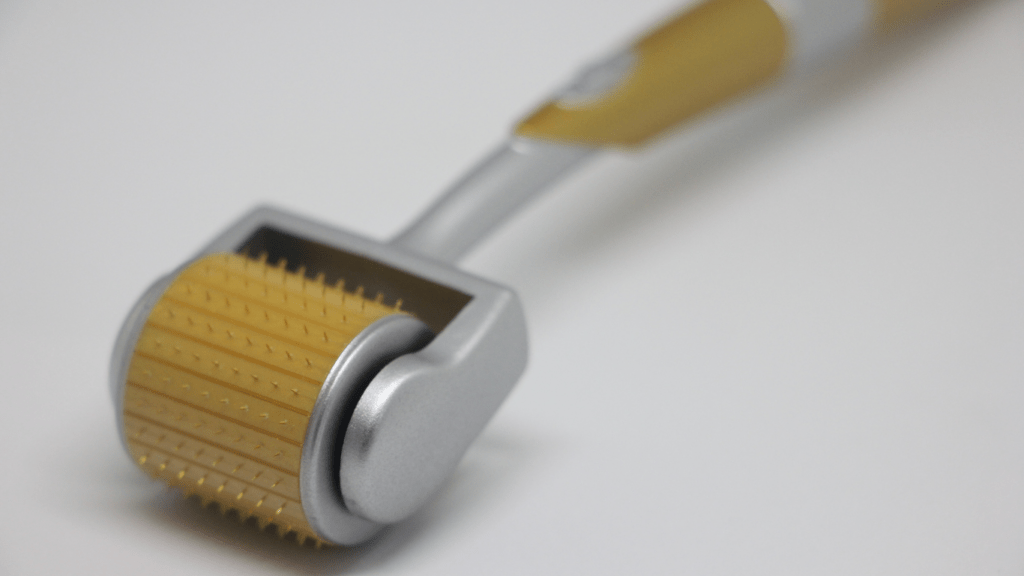What Is Microneedling?
Microneedling involves creating micro-injuries on the skin’s surface using tiny needles. These controlled punctures stimulate the body’s natural healing process, boosting collagen and elastin production. Dermatologists often use microneedling to improve skin texture, reduce scars, and diminish fine lines.
Studies show that microneedling enhances topical product absorption by up to 300%, making it effective for at-home skincare routines. Specific skin issues, such as acne scars and hyperpigmentation, see significant improvement with regular microneedling sessions.
The process typically involves a sterilized derma roller with needle lengths ranging from 0.25 mm to 2.0 mm. Shorter needles (0.25-0.5 mm) are safe for home use, while longer needles (1.0-2.0 mm) should be left to professionals. Select the appropriate needle length based on your skin concern for safe and effective results.
How Do Derma Rollers Work?
Derma rollers function by creating tiny punctures on the skin’s surface. These micro-injuries prompt the skin to initiate its natural healing process, which results in increased collagen and elastin production. Collagen and elastin are essential proteins that help maintain skin’s firmness, elasticity, and overall health.
The process of microneedling with a derma roller can significantly enhance the effectiveness of topical skincare products. By creating micro-channels, the skin’s barrier becomes temporarily more permeable, allowing ingredients to penetrate deeper and work more effectively.
Different needle lengths serve different purposes. For instance:
- 0.25-0.5 mm needles are suitable for improving the absorption of serums and creams.
- 1.0-2.0 mm needles are typically used by professionals for treating deeper skin issues like scars and wrinkles.
It’s crucial to disinfect the derma roller before and after each use to avoid infections. Clean the skin thoroughly before the procedure and apply a suitable serum post-treatment to maximize the benefits.
Benefits Of Using Derma Rollers
Derma rollers offer numerous advantages for skin health and appearance by utilizing microneedling technology to stimulate natural healing processes.
Improved Skin Texture
Microneedling enhances skin texture by promoting collagen and elastin production. After several sessions, my skin feels firmer and looks smoother. The micro-injuries created by the needles encourage cell turnover, revealing a more even complexion.
Enhanced Product Absorption
Derma rollers increase the efficacy of skincare products. Studies suggest a potential 300% improvement in absorption when using a derma roller. I notice my serums and creams penetrate deeper, showing faster and more noticeable results.
Reduced Fine Lines And Wrinkles
Consistent use of derma rollers targets fine lines and wrinkles. By boosting collagen levels, my skin appears plumper, reducing the visibility of aging signs. Even fine lines around my eyes and mouth smoothed out with regular treatments.
Minimized Scarring And Hyperpigmentation
Derma rollers effectively reduce scars and hyperpigmentation. The microneedling process breaks down scar tissue and stimulates new collagen, improving the skin’s appearance. My acne scars gradually faded, and my skin tone became more even over time.
Choosing The Right Derma Roller
Selecting the right derma roller is crucial for achieving the best results with microneedling at home. Here are key factors to consider.
Needle Size Guide
Understanding needle size within derma rollers matters because it directly affects treatment outcomes. For home use, needles ranging from 0.25 to 0.5 mm target superficial concerns like enhanced product absorption and skin texture improvement. For deeper issues like moderate acne scars and wrinkles, 1.0 mm needles may be necessary. However, ensure a professional handles anything above 1.0 mm to minimize risks. Always choose needle size based on the specific skin issue you’re addressing.
Quality And Material Considerations
The quality and material of the derma roller impact its effectiveness and safety. Look for rollers crafted from surgical-grade stainless steel or titanium for durability and hygiene. Titanium needles tend to be stronger and last longer compared to stainless steel options. Avoid cheap, low-quality rollers as they can damage the skin and deliver inconsistent results. Consider reputed brands that have positive user reviews and certifications, ensuring a reliable and safe microneedling experience.
Step-By-Step Guide To Microneedling At Home
Using derma rollers at home can be a game changer for your skincare routine. Follow this guide to ensure safe and effective microneedling.
Preparation And Skin Cleansing

Firstly, always disinfect your derma roller by soaking it in isopropyl alcohol (70%+) for 5-10 minutes. To cleanse your skin, wash your face thoroughly with a gentle cleanser to remove any makeup or impurities. Pat your skin dry with a clean towel. Using a toner can help balance your skin’s pH level.
Proper Technique
After your skin is clean, apply a hydrating serum that contains hyaluronic acid for optimal results. Now, gently roll the derma roller over your skin in horizontal, vertical, and diagonal directions. Aim for 4-5 passes per area with light pressure. Be careful around delicate areas like under your eyes and lips.
Post-Treatment Care
After microneedling, apply a hydrating serum or a gentle moisturizer to soothe your skin. Avoid products containing alcohol, retinoids, or acids immediately after the treatment to prevent irritation. Protect your skin with a broad-spectrum SPF 30+ sunscreen if you’re going out, as microneedling makes your skin more sensitive to UV rays.
Potential Risks And Precautions
- Using derma rollers at home offers many benefits, but there’s potential for risks if not used properly. The most common issue is skin irritation. Overuse or excessive pressure can lead to redness, swelling, and irritation. It’s crucial to follow recommended guidelines, using light pressure and avoiding sensitive areas.
- Infections can occur if the derma roller isn’t adequately sanitized. Always disinfect the roller before and after each use. Use rubbing alcohol to disinfect the device, and store it in a clean, dry place. Clean your face thoroughly to remove any makeup, oils, or dirt before starting the treatment to minimize the risk of bacteria entering the skin.
- Allergic reactions are possible if topical products applied after microneedling contain irritating ingredients. Choose serums and creams designed for post-microneedling care, free from fragrances, alcohol, and other potential irritants.
- Scarring can result from improper use, especially when using longer needles. Only use needles appropriate for home use, typically 0.25 to 0.5 mm. Leave longer needles for professionals to avoid damaging the skin.
- Pigmentation changes may happen, especially if your skin is prone to hyperpigmentation. Don’t microneedle over active acne, inflamed skin, or sunburned areas, as this can worsen pigmentation issues. Always apply a broad-spectrum sunscreen post-treatment, as microneedling increases the skin’s sensitivity to UV rays.
- Consult a dermatologist before starting microneedling, especially if you have underlying skin conditions. This ensures that it’s safe for your skin type and concerns, reducing the chance of complications.
By following these precautions, you can enjoy the benefits of microneedling while minimizing the risks.



